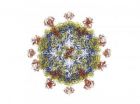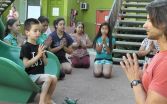(Press-News.org) HOUSTON -- (July 18, 2011) -- Rice University scientists have defined the structure -- down to the atomic level -- of a virus that causes juvenile diarrhea. The research may help direct efforts to develop medications that block the virus before it becomes infectious.
The new paper by Professor Yizhi Jane Tao, postdoctoral researcher Jinhui Dong and their colleagues was published in today's online edition of the Proceedings of the National Academy of Sciences.
Tao's Rice lab specializes in gleaning fine details of viral structures through X-ray crystallography and computer analysis of the complex molecules, ultimately pinpointing the location of every atom. That helps researchers see microscopic features on a virus, like the spot that allows it to bind to a cell or sites that are recognized by neutralization antibodies.
Among four small RNA viruses that typically infect people and animals, Tao said, astrovirus was the only one whose atomic structure was not yet known. First visualized through electron microscopy in 1975, it became clear in subsequent studies that the virus played a role in juvenile -- and sometimes adult -- outbreaks of diarrhea, as the second leading cause after rotavirus. Passed orally, most often through fecal matter, the illness is more inconvenient than dangerous, but if left untreated, children can become dehydrated.
The virus works its foul magic in humans' lower intestines, but to get there it has to run a gauntlet through the digestive tract and avoid proteases, part of the human immune system whose job is to destroy it. (Though one, trypsin, actually plays a role in activating astrovirus, she said.) When the astrovirus finds a target and viral RNA is let loose inside human cells, virus replication starts. If the host's immune system does not do a good enough job in removing the viruses, the malady will run its uncomfortable course in a couple of days.
Astrovirus bears a strong resemblance to the virus that causes hepatitis E (HEV). Tao, an associate professor of biochemistry and cell biology, said she decided to investigate astrovirus after completing a similar study of HEV two years ago. "I was thinking there's some connection between those viruses," she said. "Based on that assumption, we started to make constructs to see if we could produce, to start with, the surface spike on the viral capsid."
The capsid is a hard shell 33 nanometers wide that contains and protects its RNA. It has 30 even tinier spikes projecting from the surface, and each of those spikes may have a receptor-binding site.
Once the atomic structure of the spike was known, finding the receptor site took detective work that involved comparing genomic sequences of eight variants of astrovirus to find which were the best conserved. "Among those eight serotypes, we figured there must be a common receptor, and that should be conserved on the surface," said Dong, the paper's lead author.
In looking for the common receptor, the team found a shallow pocket in the spike that became a prime suspect for receptor binding.
The researchers also discovered the astrovirus may have a sweet tooth. "The size of the pockets suggests that it would most likely bind to sugar molecules, like disaccharides or trisaccharides," Tao said. "It may be that the virus binds to the sugar molecule and that helps it bind to the surface of a target cell."
Finally, the team also determined astrovirus resembles another of the four types of RNA-based viruses, calicivirus, although more remotely than HEV. They suspect astrovirus may be a hybrid, with parts derived from both HEV and calicivirus. "Clearly, these three are related somehow. It's an interesting point, but we can't determine that relationship based on what we know right now."
What researchers can do is begin to develop a vaccine or antiviral drug that will block astrovirus. "There's already a phase II vaccine (in trials) for HEV, so that gives us hope," Dong said.
"We will certainly work with other labs to identify compounds that can bind to this potential pocket," Tao said. "We can do this computationally. We can screen 50,000 compounds, for example, to see which may bind to the protein with high affinity. Then we can start the optimization procedure."
INFORMATION:
Co-authors of the paper are former Rice graduate student Liping Dong and Ernesto Méndez, a researcher at the National Autonomous University of Mexico.
The Welch Foundation, the National Institutes of Health and the Kresge Science Initiative Endowment Fund supported the research.
Juvenile diarrhea virus analyzed
Rice University scientists define structure of astrovirus
2011-07-19
ELSE PRESS RELEASES FROM THIS DATE:
Registration Now Open for Nicaragua's Premier Investment Forum
2011-07-19
PRONicaragua recently announced the organization of the premier investment forum titled Nicaragua, Let's Grow Together!, which will showcase the country's sustainable growth in various economic sectors and its competitive advantages as an attractive destination for foreign direct investment (FDI).
The event will take place on August 16th and 17th in Managua, Nicaragua, and will focus on specialized sectors such as apparel, footwear, food processing and manufacturing, as well as world-class bilingual business process outsourcing (BPO) services. Participants will be coming ...
IBD, LCPD health research in 'Westie' dogs may hold answers to similar human diseases
2011-07-19
The Westie Foundation of America (WFA) announced
today preliminary findings in two major studies involving the health of West Highland White Terriers also
known as Westies. Findings in these and other studies of Westies and other dogs
may hold answers for similar human conditions like Inflammatory Bowel Disease (IBD). The studies are
jointly funded by the WFA and the AKC Canine Health Foundation (CHF).
In one study, researchers are looking at the role of a mucosal gene driving inflammation Canine IBD, a
chronic intestinal disorder that creates a bacterial-driven ...
Decisions, decisions, decisions ...
2011-07-19
We all make numerous decisions everyday; unconsciously or consciously, sometimes doing it automatically with little effort or thinking and yet, at other times, we agonize for hours over another. Why do we make these choices – be it from deciding what to have for lunch or whether to say yes to that job offer halfway round the world. Sometimes we make choices on our own, and at other times, the choice is made for us. Exercising control (by making choices) is adaptive and now, a new study, which will be published in an upcoming issue of Psychological Science, a journal of ...
Domestic Violence Charity Announces Fat Burn America Tour: 100 Cities in 100 Days
2011-07-19
What does a passionate founder of a domestic violence charity do when he wants to raise awareness and promote a daily fitness program? Rich Tola, Founder and Chairman of the yoga-inspired nonprofit, The Boulevard Zen Foundation, would say "We're going on a 30,000 mile fundraiser, visiting all 50 states in 100 days. That's 100 cities in 100 days, producing trivia-filled travelogue videos including fat burning workouts that are based on yoga". Ambitious? Yes. Impossible? "Certainly not," says the former Wall Streeter turned actor-filmmaker whose film, ...
Key metabolic pathway implicated in intractable form of breast cancer
2011-07-19
FINDINGS: Using a new in vivo screening system, Whitehead Institute researchers have identified a protein in a key metabolic pathway that is essential in estrogen receptor (ER)-negative breast cancer. When the expression of the gene that codes for this protein—phosphoglycerate dehydrogenase or PHGDH—is suppressed in tumors and cell lines with an overabundance of the protein, the rate of cellular growth declines markedly.
RELEVANCE: PHGDH is overexpressed in approximately 70% of ER-negative breast cancer patients. Patients with ER-negative disease respond poorly to treatment ...
Penn researchers find neural signature of 'mental time travel'
2011-07-19
PHILADELPHIA — Almost everyone has experienced one memory triggering another, but explanations for that phenomenon have proved elusive. Now, University of Pennsylvania researchers have provided the first neurobiological evidence that memories formed in the same context become linked, the foundation of the theory of episodic memory.
The research was conducted by professor Michael Kahana of the Department of Psychology in the School of Arts and Sciences and graduate student Jeremy R. Manning, of the Neuroscience Graduate Group in Penn's Perelman School of Medicine. They ...
Single traumatic brain injury may prompt long-term neurodegeneration
2011-07-19
PHILADELPHIA - Years after a single traumatic brain injury (TBI), survivors still show changes in their brains. In a new study, researchers from the Perelman School of Medicine at the University of Pennsylvania suggest that Alzheimer's disease-like neurodegeneration may be initiated or accelerated following a single traumatic brain injury, even in young adults.
Over 1.7 million Americans suffer a traumatic brain injury each year, and beyond the immediate effects, growing evidence demonstrates that a single TBI may initiate long-term processes that further damage the brain. ...
USC research: Cancer cells and stem cells share same origin
2011-07-19
Oncogenes are generally thought to be genes that, when mutated, change healthy cells into cancerous tumor cells. Scientists at the Keck School of Medicine of the University of Southern California (USC) have proven that those genes also can change normal cells into stem-like cells, paving the way to a safer and more practical approach to treating diseases like multiple sclerosis and cancer with stem cell therapy.
"The reality may be more complicated than people think," said Jiang F. Zhong, Ph.D., assistant professor of pathology at the Keck School. "What is a stem cell ...
Hydrogen may be key to growth of high-quality graphene
2011-07-19
OAK RIDGE, Tenn., July 18, 2011 – A new approach to growing graphene greatly reduces problems that have plagued researchers in the past and clears a path to the crystalline form of graphite's use in sophisticated electronic devices of tomorrow.
Findings of researchers at the Department of Energy's Oak Ridge National Laboratory demonstrate that hydrogen rather than carbon dictates the graphene grain shape and size, according to a team led by ORNL's Ivan Vlassiouk, a Eugene Wigner Fellow, and Sergei Smirnov, a professor of chemistry at New Mexico State University. This ...
Nova Scotia - Best Beaches in Canada
2011-07-19
With more than 7,600 kilometers of shoreline and over 100 beaches, there's a good reason Nova Scotia is home to the best beaches in Canada. The province is a great place to have fun in the sun and dip your toes in the water. From the red cliffs and warm sands of the Northumberland shore, to the white sands and cobbled shores of the Atlantic, there's a favourite spot for everyone. This summer, check out our personal top ten Nova Scotia beaches.
Top 10 Beaches in Nova Scotia
Ingonish Beach
Located on the Cabot Trail just outside of the Highlands National Park, this ...
LAST 30 PRESS RELEASES:
NTIDE: Disability employment holds steady after data hiatus
Social lives of viruses affect antiviral resistance
Dose of psilocybin, dash of rabies point to treatment for depression
Helping health care providers navigate social, political, and legal barriers to patient care
Barrow Neurological Institute, University of Calgary study urges “major change” to migraine treatment in Emergency Departments
Using smartphones to improve disaster search and rescue
Robust new photocatalyst paves the way for cleaner hydrogen peroxide production and greener chemical manufacturing
Ultrafast material captures toxic PFAS at record speed and capacity
Plant phenolic acids supercharge old antibiotics against multidrug resistant E. coli
UNC-Chapel Hill study shows AI can dramatically speed up digitizing natural history collections
OYE Therapeutics closes $5M convertible note round, advancing toward clinical development
Membrane ‘neighborhood’ helps transporter protein regulate cell signaling
Naval aviator turned NPS doctoral student earns national recognition for applied quantum research
Astronomers watch stars explode in real time through new images
Carbon-negative building material developed at Worcester Polytechnic Institute published in matter
Free radicals caught in the act with slow spectroscopy
New research highlights Syntax Bio’s platform for simple yet powerful programming of human stem cells
Researchers from the HSE University investigated reading in adolescents
Penn Nursing study: Virtual nursing programs in hospitals fall short of expectations
Although public overwhelmingly supports hepatitis B vaccine for a newborn, partisan differences exist
DFW backs UTA research to bolster flood resilience
AI brain scan model identifies stroke, brain tumors and aneurysms – helping radiologists triage and speed up diagnoses
U.S. News & World Report gives Hebrew Rehabilitation Center highest rating
Optica and DPG name Antoine Browaeys 2026 Herbert Walther Award recipient
The presence of a gun in the home increases the risk of suicide by three to five times
PFAS exposure and endocrine disruption among women
Vaccines and the 2024 US presidential election
New approach narrows uncertainty in future warming and remaining carbon budget for 2 °C
When pregnancy emergencies collide with state abortion bans
American College of Cardiology supports front of package nutrition labeling
[Press-News.org] Juvenile diarrhea virus analyzedRice University scientists define structure of astrovirus


